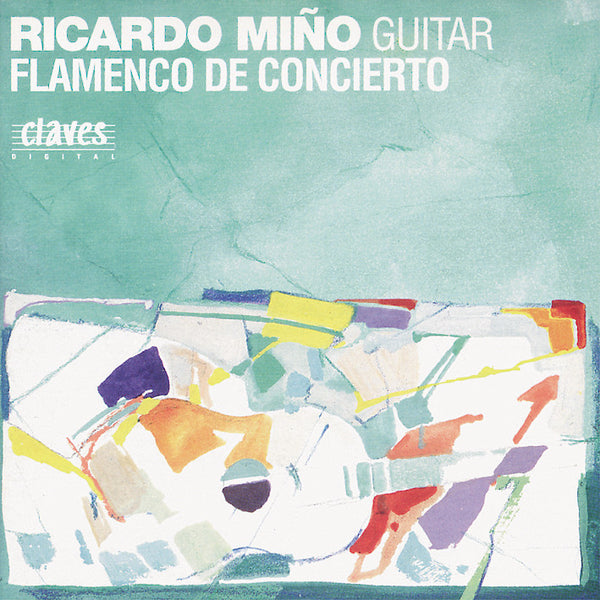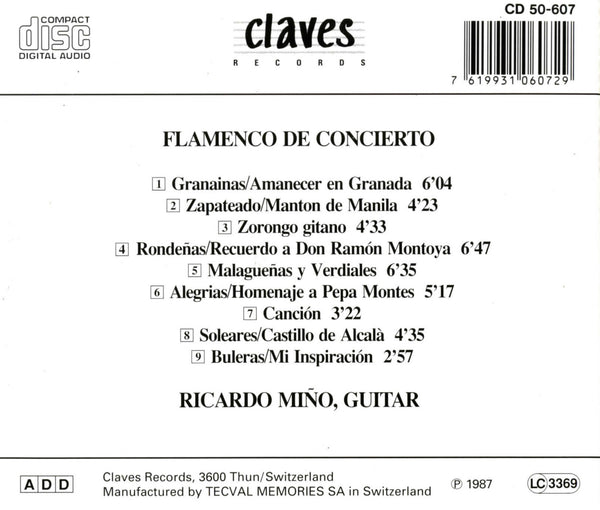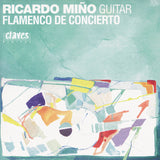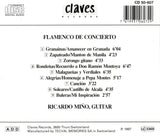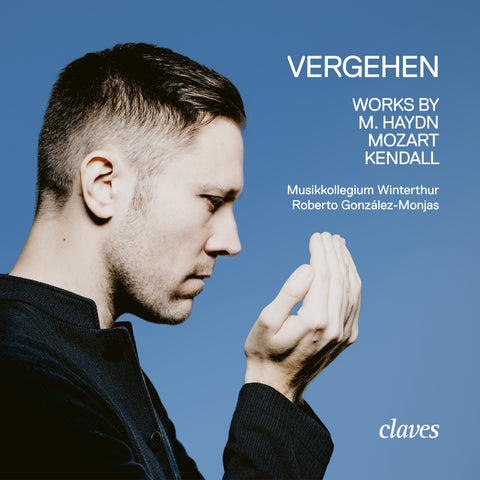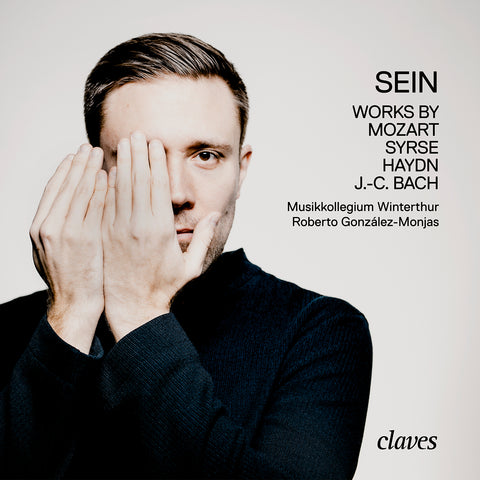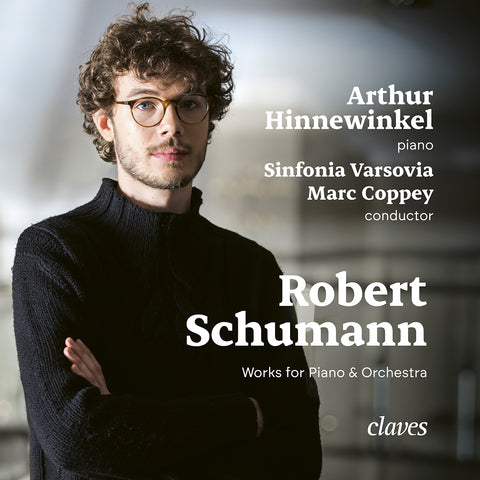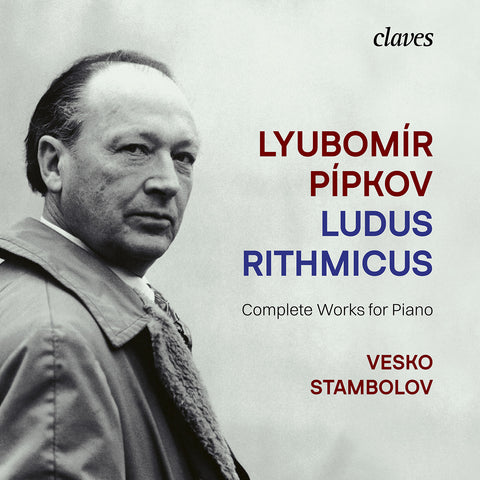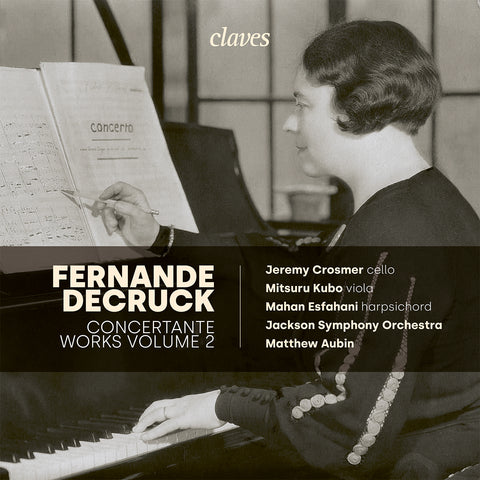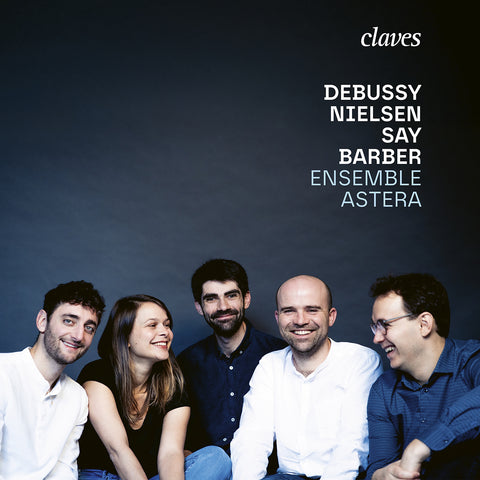(1987) Flamenco De Concierto
CD set: 1
Catalog N°:
CD 0607
Release: 1987
EAN/UPC: 7619931060729
- UPC: 829410601962
This album is now on repressing. Pre-order it at a special price now.
CHF 18.50
This album is no longer available on CD.
This album has not been released yet. Pre-order it from now.
CHF 18.50
This album is no longer available on CD.
CHF 18.50
VAT included for Switzerland & UE
Free shipping
This album is no longer available on CD.
VAT included for Switzerland & UE
Free shipping
This album is now on repressing. Pre-order it at a special price now.
CHF 18.50
This album is no longer available on CD.
This album has not been released yet.
Pre-order it at a special price now.
CHF 18.50
This album is no longer available on CD.
CHF 18.50
This album is no longer available on CD.
FLAMENCO DE CONCIERTO
Ricardo Miño was born in Seville in 1949. Despite the fact that he was born in the heart of the flamenco country of Seville, la cava de los gitanos, he was the first member of his family to choose flamenco as a profession. Like so many other young Andalusians, he was fascinated by flamenco art, an art peculiar to the Andaluaians. Ricardo was to be found wherever there were leading flamenco and he very soon feil under the spell of that magnificent instrument - the flamenco guitar.
He had already achieved great fame throughout Spain at an early age and for two years accompanied Pépé Marchena, one of the best known of contemporary flamenco singers. He also took part in flamenco festivals in Cordoba, Seville and Grenade, the acknowledged centers where the art flourishes and where competitions are held every three years in all aspects of the art - singing, guitar playing and dancing.
At the last Cordoba festival he won the first price for guitar thus adding his name to the outstanding exponents of the flamenco guitar. Contracts flooded in and he performed in many countries, not only in Europe, but also in Latin-America and many oriental countries.
From 1969 onwards he was a regular performer at the Fiesta Gitana, the biggest flamenco event outside Spain itself, and as first guitarist made many tours with the company in leading world concert halls.
But his playing is not solely confined to the accompaniment of singing and dancing: Ricardo Miño has also done many solo performances with resounding success. He has thus demonstrated that he belongs to a new race of flamenco guitarists who do not confine themselves to accompaniment, but also see their instrument as a means of solo interpretation with almost limitless possibilities.
Flamenco de concierto
In flamenco the guitar was originally used to accompany singing and dancing. The technique is extremely difficult and differs in important ways from classical guitar playing. A marked feature of flamenco playing is the mastery of tempo-'compas’. With a good flamenco artist this measure comes, as it were, from his subconscious, without the intervention of conscious thought. What he plays is not part of a composition in the classical sense. The flamenco guitarist uses the word toque to describe the whole art of flamenco - the traditional singing and dancing - and this is further defined by what he himself plays.
Melodic variations introduced into the toque are called falsetas and require various righthand techniques known as rasgueos. There are many of these and they are the basis of flamenco guitar playing. One of the rasgueos for example, consists of sliding the fingers over each string separately in one continuous movement, resulting in a kind of ’droning' sound. The thumb of the right hand also has an extremely important function in flamenco guitar technique and special effects can be achieved with it.
Other techniques that can be mentioned are the picado, the arpegio and the tremolo and in flamenco guitar technique are performed as follows: The picado consists chiefly of the rapid plucking of one string alternately by the index and middle finger, the middle and the third finger, or the index and third finger. The arpegios are executed by the thumb plucking the bass string, plus a given high toned string, alternated by two, three of four fingers.
Left hand technique is reserved for chords and ligado. The ligado occurs when a finger is slid over a string and lifted to produce a tone. For this all the fingers but not the thumb are used. This technique is most important in flamenco guitar playing. Until about 20 or 30 years ago all flamenco guitarists used this technique exclusively to accompany singing and dancing.
Ramon Montoya (1880-1955), himself an eminent guitarist - deserves the credit for having drastically revised the role of the flamenco guitarist as simply an accompanist. Influenced by classical guitar playing he applied some of the classical techniques to flamenco playing, in particular to the tremolo, the arpegio and the picado. The left hand also became stronger and more complex. This gave rise to a style of guitar playing known in flamenco as flamenco de concierto. Although it has absorbed many classical influences it has remained predominantly flamenco.
However great the virtuosity thus introduced, the compas (tempo) always has to be respected and the duende - a flamenco expression meaning 'inner dignity’ - has to be preserved. Every good flamenco guitar player is in fact a composer, spontaneously weaving his emotions into what he is playing.
ln Ricardo Miño we have one of our most brilliant contemporary guitar players, a follower of the flamenco de concierto, and it is on this recording that he demonstrates in his own inimitable way his inspiration by traditional Andalusian songs.
(1987) Flamenco De Concierto - CD 0607
Ricardo Miño was born in Seville in 1949. Despite the fact that he was born in the heart of the flamenco country of Seville, la cava de los gitanos, he was the first member of his family to choose flamenco as a profession. Like so many other young Andalusians, he was fascinated by flamenco art, an art peculiar to the Andaluaians. Ricardo was to be found wherever there were leading flamenco and he very soon feil under the spell of that magnificent instrument - the flamenco guitar.
He had already achieved great fame throughout Spain at an early age and for two years accompanied Pépé Marchena, one of the best known of contemporary flamenco singers. He also took part in flamenco festivals in Cordoba, Seville and Grenade, the acknowledged centers where the art flourishes and where competitions are held every three years in all aspects of the art - singing, guitar playing and dancing.
At the last Cordoba festival he won the first price for guitar thus adding his name to the outstanding exponents of the flamenco guitar. Contracts flooded in and he performed in many countries, not only in Europe, but also in Latin-America and many oriental countries.
From 1969 onwards he was a regular performer at the Fiesta Gitana, the biggest flamenco event outside Spain itself, and as first guitarist made many tours with the company in leading world concert halls.
But his playing is not solely confined to the accompaniment of singing and dancing: Ricardo Miño has also done many solo performances with resounding success. He has thus demonstrated that he belongs to a new race of flamenco guitarists who do not confine themselves to accompaniment, but also see their instrument as a means of solo interpretation with almost limitless possibilities.
Flamenco de concierto
In flamenco the guitar was originally used to accompany singing and dancing. The technique is extremely difficult and differs in important ways from classical guitar playing. A marked feature of flamenco playing is the mastery of tempo-'compas’. With a good flamenco artist this measure comes, as it were, from his subconscious, without the intervention of conscious thought. What he plays is not part of a composition in the classical sense. The flamenco guitarist uses the word toque to describe the whole art of flamenco - the traditional singing and dancing - and this is further defined by what he himself plays.
Melodic variations introduced into the toque are called falsetas and require various righthand techniques known as rasgueos. There are many of these and they are the basis of flamenco guitar playing. One of the rasgueos for example, consists of sliding the fingers over each string separately in one continuous movement, resulting in a kind of ’droning' sound. The thumb of the right hand also has an extremely important function in flamenco guitar technique and special effects can be achieved with it.
Other techniques that can be mentioned are the picado, the arpegio and the tremolo and in flamenco guitar technique are performed as follows: The picado consists chiefly of the rapid plucking of one string alternately by the index and middle finger, the middle and the third finger, or the index and third finger. The arpegios are executed by the thumb plucking the bass string, plus a given high toned string, alternated by two, three of four fingers.
Left hand technique is reserved for chords and ligado. The ligado occurs when a finger is slid over a string and lifted to produce a tone. For this all the fingers but not the thumb are used. This technique is most important in flamenco guitar playing. Until about 20 or 30 years ago all flamenco guitarists used this technique exclusively to accompany singing and dancing.
Ramon Montoya (1880-1955), himself an eminent guitarist - deserves the credit for having drastically revised the role of the flamenco guitarist as simply an accompanist. Influenced by classical guitar playing he applied some of the classical techniques to flamenco playing, in particular to the tremolo, the arpegio and the picado. The left hand also became stronger and more complex. This gave rise to a style of guitar playing known in flamenco as flamenco de concierto. Although it has absorbed many classical influences it has remained predominantly flamenco.
However great the virtuosity thus introduced, the compas (tempo) always has to be respected and the duende - a flamenco expression meaning 'inner dignity’ - has to be preserved. Every good flamenco guitar player is in fact a composer, spontaneously weaving his emotions into what he is playing.
ln Ricardo Miño we have one of our most brilliant contemporary guitar players, a follower of the flamenco de concierto, and it is on this recording that he demonstrates in his own inimitable way his inspiration by traditional Andalusian songs.
Return to the album | Main Artist: Ricardo Miño






